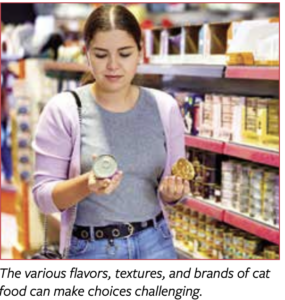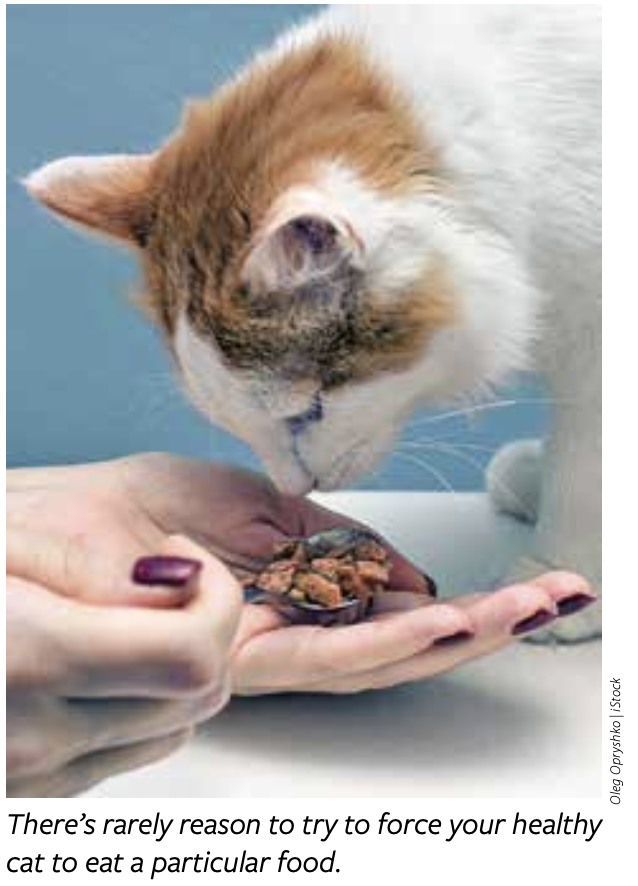Ask 10 people what you should feed your cat, and you’ll get 15 different opinions. Wet, or canned food is extremely popular with many cat lovers and their felines, but this does not mean it is a must for every cat.
“It really depends on the health status of the cat,” says Joseph J. Wakshlag, DVM, PhD, chief of nutrition at Cornell University’s College of Veterinary Medicine. Wet food has some pros over dry food, but dry food has its merits too.
Good Nutrition in Many Forms
The only two absolute requirements when feeding your cat are:
- The diet should be complete and balanced to provide your cat with everything she needs.
- Your cat needs to like and eat the food you choose to feed.
Commercially made cat foods should have an AAFCO (Association of American Feed Control Officials) statement on the label declaring that the food has been formulated to meet the needs of your cat’s life stage. If there is nothing like that on the label or the label says a food is “for supplemental feeding only,” it is not a complete and balanced diet. Your cat can still eat this item, but it shouldn’t make up the bulk of her diet, no matter what she tries to tell you.

Canned foods and kibble can both be complete and balanced. If you are making food for your cat at home, use a recipe designed by a veterinary nutritionist and don’t skip any ingredients to make sure your cat is getting everything she needs.
Palatability
It is easy to be so focused on the ingredients and manufacturing of cat foods that we forget the simplest, most basic requirement for cat food: Your cat must eat it.
Many cats find wet food to be tastier, but that is not always the case. Some cats really enjoy the crunch of kibble and refuse to eat anything else.
When adding a new cat to the family, it can help to offer a variety of different textures and flavors to see what she prefers. Major life changes are stressful, and having her favorite food available can encourage normal eating habits. Once your cat has settled into the new routine, you can try adding a little bit of canned food to her kibble if desired.
Pros of Wet Food
Canned food does have some benefits for your cat’s health.
First is the higher moisture content. Many cats aren’t big drinkers, so feeding wet food is an easy way to increase your cat’s water consumption. This will help to keep your cat hydrated even if she is not drinking much and can be beneficial for cats prone to urinary tract issues or with kidney disease.
Wet food is also often higher in protein and lower in carbohydrates than dry food. This can help for diabetic cats who need limited carbs in their diet to help regulate their insulin levels.
In a more general sense, canned foods are often the best choice for sick or injured cats because they are easy to eat and often have a rich, meaty aroma. Warming the wet food further increases the aroma, which can entice a sick cat to eat.
Cats Who Need Wet Food
While the average healthy cat will do just fine on either a wet or dry diet, some health conditions do call for a wet diet when possible.
“If there are urinary issues then canned wins, since hydration is necessary,” says Dr. Wakshlag. The higher moisture content in the wet food helps to flush the urinary tract and promote urinary health.
Many veterinarians also recommend canned prescription diets for chronic kidney disease. These prescription diets are specially formulated to support your cat’s kidneys, and the higher moisture content in the canned food helps to keep your cat hydrated.
Wet food may be needed short-term if your cat has oral surgery to remove teeth or a tumor from the mouth. The softer wet food is less likely to irritate your cat’s mouth as she heals.
If your cat has a health condition that calls for a wet diet, make the transition gradually. If your cat flat-out refuses to eat the wet food, talk with your veterinarian about adding water to her preferred kibble or other alternatives to both keep your cat eating and support her health.
Bottom Line
While wet food is not required for cats, “I think, in general, it’s good to get your cat to eat both wet and dry foods early on so you can switch to what is needed depending on the health issues with your cat,” says Dr. Wakshlag.



